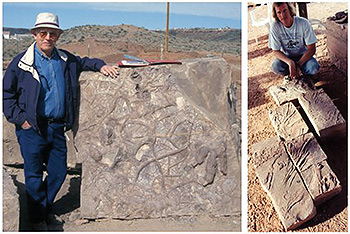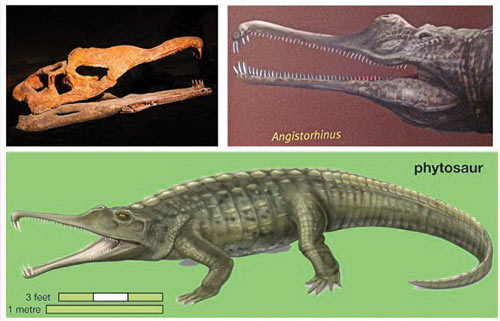 |
| The Saint George Dinosaur Discovery Site (SGDS) at Johnson Farms was discovered by Sheldon Johnson (left) in 2000. He and his wife LaVerna donated the site to the city and helped create an on-site Museum. Andrew Milner (right) seen here showing a rare series of swim tracks theropod dinosaur swim tracks is the SGDS paleontologist. He has found many track and bone sites in the area and other parts of Utah. |
The legend of Saint George, dragon-slaying patron saint of England and a few other countries, goes back at least two millennia to the Greeks, before England was England! Legends of dragons go back even further to Mesopotamia, around 2000 BCE, and perhaps earlier in China. The Chinese word for dragon is lóng and the word for dinosaur is Kǒnglóng and there are even books about dinosaurs with titles like The Dragon Hunters, not to mention stories like King Kong. Dragons, like dinosaurs, have perennial fascination for kids and paleontologists. Dragon myths probably have their origins in our human (primate) fear of snakes, crocodiles, Komodo dragons and other dangerous wild animals. Even if they may sometimes encounter dangerous snakes or crocodiles, the modern paleontologist does not have to go out and kill dinosaurian dragons as they are already dead! The paleontologist’s goal is to then bring them back to life.
In this People in Paleo series I have not needed to step outside the Dinosaur Diamond to report on the many paleontologists working in the area. This month’s focus on Andrew Milner, a paleontologist from the Saint George Dinosaur Discovery Site at Johnson Farms, is no exception. Although known for his work in the St. George area, Andrew and his colleagues have done much work in the Moab-Monticello area. There is no obvious connection between George Smith after whom St. George Utah was named in 1861, and ancient St. George the dragon slayer. George was dubbed the “potato saint” and advocated eating raw potatoes to prevent scurvy. However, the dinosaur connections are strong, and historically Moab and St. George are connected by the Spanish Trail. Today, St. George ranks as the number 2 dinosaur tracksite in the
USA, while the Mill Canyon and Stomping Ground sites in the Dinosaur Diamond rank number 7 and number 8 respectively. Increasingly tourist byways like the Dinosaur Diamond become dinosaur trails that connect a growing number of dinosaur destinations.
 |
| When not working in the Saint George area Andrew Milner has found many Late Triassic fossils in San Juan County including phytosaurs. These crocodile look-alikes were the largest animals known from this epoch, and could be described as the most dangerous dragons of their day. |
So, what are Andrew Milner and his colleagues up to when they retrace the Spanish Trail from St George to Moab? The answer is that he is dragon hunting, enthusiastically focused on the evolution of dinosaurs, other vertebrates, plants and even environments in the Late Triassic Chinle Formation in San Juan County. This rock formation, famous farther south for the Petrified Forest and Painted Desert has produced such diverse evidence as fish, footprints and the skeletal remains of dinosaurs and other large reptiles. These, latter include the large, armored crocodile-like Phytosaurs, which grew as large or larger than modern crocodiles at 10- 12 meters (33-39 feet), and are often well preserved. Andrew’s finds and much work done by his colleague Randall Irmis (Chief Curator and a Curator of Paleontology at the Natural History Museum of Utah) shed light on early vertebrate evolution in the Late Triassic between 230-200 million years ago. This time interval is fossil-rich around the world and so has attracted much attention. Many publications deal with details of how dinosaurs and other reptilian groups including crocodilian relatives evolved. Specialists like Irmis and Milner help us trace head to toe complexities of this phase of vertebrate evolution from ankles to teeth and palates. Paleontologists find it intriguing that the dinosaurs (good ankles) emerged very successful from this epoch. The earlier history of reptile evolution is almost as complex as the evolution of dragon mythology. The difference is that the dragon bones from the Chinle Formation of San Juan County are real, tangible fossils. A four-foot long phytosaur skull is no myth, but it still resembles a fearsome dragon. Many ancient legends and myths deal with extraordinary never-previously-discovered creatures that emerge from the earth. What s does that sound like? In some cases these creatures were turned to stone and have to be extracted and revived by helpful heroes, AKA paleontologists.
|